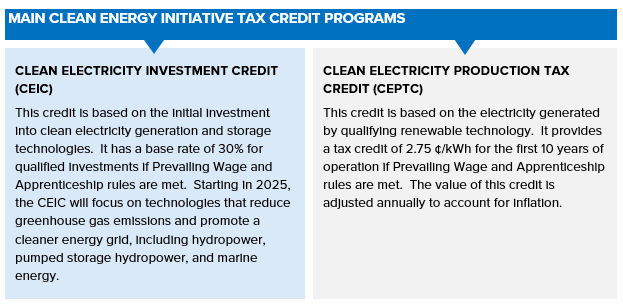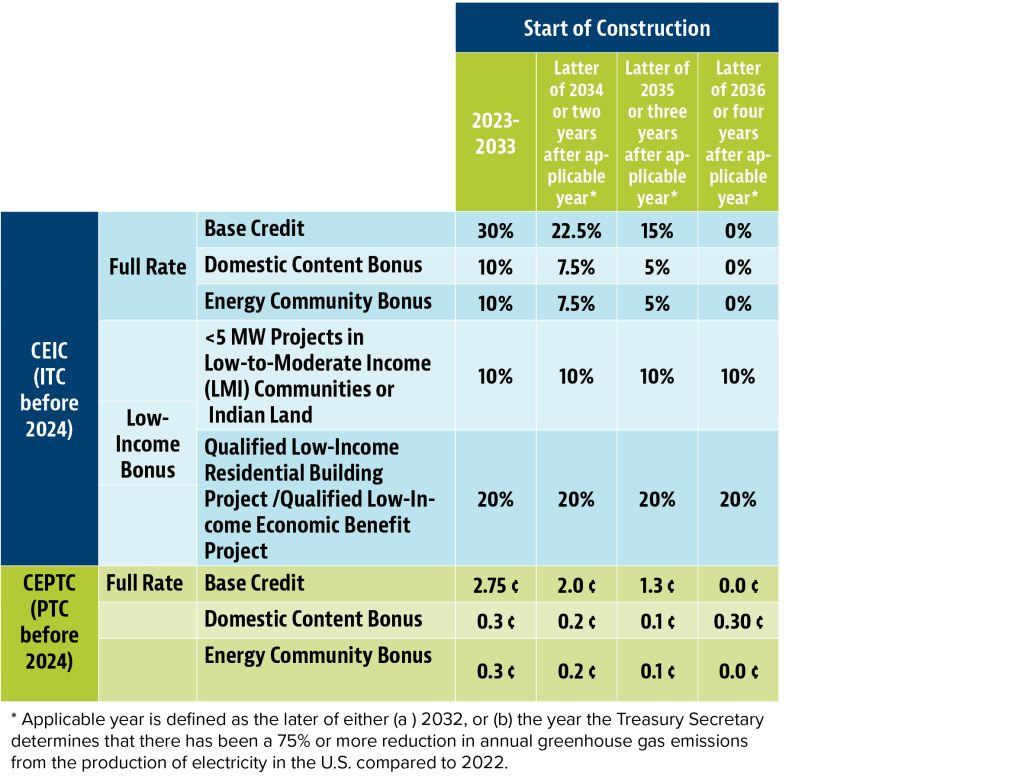Now is your opportunity to take advantage of financial incentives and incorporate renewable energy into your operations. The Clean Energy Tax Incentives for Businesses through the Inflation Reduction Act allows municipalities, other tax-exempt entities, and nonprofit organizations to fund renewable energy projects such as wind and solar. Once you have a plan, follow the Federal guidelines to apply for tax credits or direct payments to offset your renewable energy expenditure so you can take full advantage of the incentives to add clean electricity to your system.
Applicable Technologies
Tax-exempt entities, like States, local governments, Tribes, territories, and nonprofits, can claim direct pay incentives for eligible technologies based on the US Department of the Treasury’s guidance on technology-neutral tax credits. The list includes:
- Wind
- Solar (photovoltaic and concentrating)
- Marine
- Waste heat recovery from any of the technologies above
In addition, the following storage technologies can also qualify:
- Electric
- Thermal
- Hydrogen
Financial Incentives

The initiative includes two main incentives and bonus add-ons to enhance the financial incentive if certain conditions are met. Note that most projects can claim either the CEIC or the CEPTC, but both cannot be claimed on the same project.
Bonus Tax Credits:
Multiple bonus opportunities offer additional options to receive credits for transitioning to cleaner energy sources. Leveraging these credits can help you boost your financial benefit from the program, improve sustainability, and enhance community resilience. The defined bonuses include:
- Domestic Content: A project that meets the defined domestic content requirements for steel, iron, and manufactured products can receive an additional 10% CEIC or an additional 10% CEPTC added to the base credit.
- Energy Community: Clean energy projects in “Energy Communities” can receive an additional 10% CEIC or an additional 10% CEPTC added to the base credit. Energy Communities are defined as follows:
- A brownfield site (land that has been polluted by industrial activity); or
- An area that has had high levels of fossil fuel-related employment since December 31, 2009, and has had an unemployment rate at or above the national unemployment rate over the previous year; or
- An area in which a coal mine has closed after December 31, 1999, or a coal-fired electric generating unit has been retired after December 31, 2009.
To determine if your service area falls within a defined Energy Community, please refer to the map on the Department of Energy’s website: Section 48C Tax Credits – Designated Energy Communities (doe.gov)
- Low-Income Community: The Low-Income Communities Bonus Credit offers additional financial incentives for clean energy projects located in or benefitting low-income communities. The goal is to make sure that the transition to clean energy is inclusive.
Municipal clients can leverage this credit by prioritizing clean energy projects in underserved communities. For instance, installing solar panels on schools, community centers, or affordable housing units can qualify for the bonus credit. This approach not only helps reduce energy costs for these facilities but also makes sure that low-income residents benefit directly from clean energy investments.
Such projects may receive an additional 10% CEIC credit and must be limited to 5 megawatts or less in capacity. Distributed energy systems installed in low-income residential buildings or on their property can claim a 20% CEIC credit (in place of the 10%) if the system generates enough energy to cover at least 50% of the building’s total energy needs.
Program Cost Savings
The table below shows how the two tax credits (ITC and PTC) can work overtime, with additions of the bonus credits to the base credits. The two programs apply to systems placed in service in 2022 or later and begin construction before 2033. (Projects that begin in 2024 are under the ITC and PTC programs). Initiatives are eligible for a 30% ITC or 2.75¢/kWh PTC plus bonuses if they meet labor requirements issued by the Treasury Department or are under one Megawatt (MW) in size. Note: these are the maximum potential credits, and there are other deductions that can reduce the actual amount for which your project may qualify.

Strategies for Municipalities
The following steps should be considered when using the CEIC and Low-Income Communities Bonus Credit to provide community benefits:
1. Comprehensive Energy Planning
A strategic energy plan will identify the best opportunities for clean energy investments. Municipal clients should conduct energy audits of public buildings and infrastructure to determine where clean energy technologies can have the most significant impact. This planning should include assessing potential sites for solar, wind, and storage installations, considering factors such as energy demand, site suitability, and community needs.
2. Engaging Stakeholders
By involving residents, businesses, and local organizations in the planning and decision-making process, you can make sure projects address local needs and gain broad support, especially in low-income communities, where trust and collaboration can enhance the effectiveness of clean energy initiatives.
3. Leveraging Additional Funding Sources
While the CEIC and the Low-Income Communities Bonus Credit provide significant financial support, you should explore other funding sources for clean energy projects. State and local grants, utility rebates, and public-private partnerships can be combined with other funding sources to help you take on larger, more impactful projects.
4. Monitoring and Reporting
Establish clear metrics for evaluating the performance of your clean energy investment, including energy savings, greenhouse gas reductions, and community benefits. Regular reporting can help demonstrate the value of these projects to stakeholders and secure ongoing support.
Key Takeaway
The CEIC and CEPTC provide substantial financial incentives for transitioning to renewable energy sources. Beginning with the base credit, communities can add bonus initiatives to recover up to 70% of clean energy transition costs, making these projects financially feasible and more beneficial. This approach reduces energy expenses, lessens dependence on fossil fuels, and offers communities a valuable opportunity to enhance sustainability and resilience.
Evaluating renewable energy opportunities for your organization is a good first step. Maximum program incentives are in place until 2033, and developing a comprehensive energy plan to incorporate these benefits could prove to be a wise decision for your utility and community.
For more information about the Clean Energy Initiative or for assistance in tailoring a funding approach, contact Adam Wahler, PE, AE2S Electrical Practice Leader.
